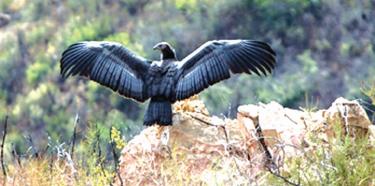
Chick #412 stretches its wings in a photo believed to have been taken near Hopper Mountain by Rick Throckmorton.
$40,500 Reward for Capture of Shooter
The Center for Biological Diversity has hired Los Angeles private investigator Bruce Robertson and boosted the award fund to $40,500 for information leading to the arrest and conviction of those responsible for the recent shooting of two endangered California Condors.
The California Department of Fish and Game announced last week that biologists found a juvenile female condor suffering from lead poisoning and with three shotgun pellets lodged in her wing and thigh. This discovery came just three weeks after biologists found another condor with 15 shotgun pellets lodged in its body. Both were part of a flock focused on the central coast of California.
“We’re doing everything we can to help solve this crime,” said Adam Keats, director of the center’s Urban Wildlands Program. “California Condors are special birds, still critically endangered….”
With a 9.5 foot wingspan, California Condors are the largest land bird in North America. They soar, rather than fly, explains Dr. Noel Snyder, who believes they evolved near the Mountain Communities, soaring from the ridges of what we know today as Tejon Ranch to ride the strong winds rushing up from the floor of the San Joaquin Valley. Those winds and ridges are the key to propelling the birds into the Sierra Nevada and back to the coastal range. Historically, their wild foraging range extended up to 150 miles per day and spread throughout both ranges, with the high elevations of Tejon Ranch at the fulcrum of the endangered bird’s habitat.
Background
Only about 85 of the birds soar wild in California skies today, making the shooting of the two juveniles in the last few weeks all the more serious.
California Condor are intelligent and unique, living up to 70 years. They mate for life, and couples lay only a single egg every two years, so each chick is carefully nurtured. The young stay with their elders for about eight to nine years, learning the secrets of their roosting, nesting and foraging range. They reach maturity and take a life-mate at seven to nine years of age.
The total population of California Condor left on earth plunged to 22 in the mid-1980s, when six suddenly died in a single year, likely from lead poisoning from eating carrion killed by hunters using lead ammunition.
As a desperate measure, the remaining birds were captured (the last two on Tejon Ranch) and brought into zoos for a captive breeding program. Reintroduction into the wild began in year 2000.
The oldest remaining bird, one of the first to be returned to the wild, was the matriarch known as AC-8, believed by Snyder, the authority on wild California Condor, to be over 56 years of age.
Released after 14 years in captivity, AC-8 almost immediately returned to explore her prior habitat—rediscovering the Tejon Ranch ridges that served as her portal connecting the coastal range habitat and that of the Sierra Nevadas.
She was shot and killed on Tejon Ranch property by a hunter in one of the ranch’s commercial pig hunts in February 2003.
Because of her unique knowledge of the habitat, and because captive-bred juvenile birds were just being introduced to the wild, there has been speculation about whether the loss of her knowledge was a severe blow to the condor recovery program.
In an interview in February, Snyder told The Mountain Enterprise that he believes the California Condor may be able exist as wild birds (rather than “on the dole” with hand-outs at feeding stations) if they can retain access to the Tehachapi uplands on the northern ridges of the Tejon portion of the condor’s critical habitat, allowing the birds to catch the uplifting winds to soar toward the inland range.
In May 2008 seven birds were taken from the wild after becoming ill from lead poisoning, believed to be from scavenging hunters’ “gut piles” on Tejon Ranch, despite a ban on lead ammunition by the ranch and other areas of condor habitat by the state of California in 2008. One of those birds died, the other six are going through chelation treatment.
Still, those seven young birds had found their way—on their own—back to the Tejon ridges and foraging areas, according to Snyder. He also said he believes the “gut piles” associated with Tejon’s commercial hunting program can be a positive factor in the condor’s return to wild ways—if lead ammunition fragments were no longer a threat.
The total population of California Condor in the world is now about 320. Half are still in zoos as part of the captive breeding program. In addition to the approximately 80 relearning their historical California habitat, about 40 have been released in Baja California and another 40 or so in Arizona.
Anyone with information regarding the recent shootings should call the Center for Biological Diversity’s condor investigation hotline at (415) 632-5300, the U.S. Fish and Wildlife Service at (916) 414-6660 or the California Department of Fish and Game’s CalTIP Program at 1 (888) DFG-CALTIP.
—Reported by Patric Hedlund
This is part of the April 17, 2009 online edition of The Mountain Enterprise.
Have an opinion on this matter? We'd like to hear from you.


